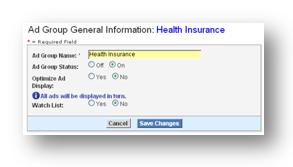YSM’s Quirky Little Feature, Optimize Ad Display

It is a difficult task to try and deny the progress Yahoo!’s Panama interface has made from the Overture days of the not-so-distant past. As a matter of fact, it simply may be impossible. In the months since its launch, I’ve grown to trust the new look, feel and usability of Yahoo!’s new advertising platform.
Along the way I’ve been able to laugh, cry and learn right along with everyone else in the industry. But despite my platonic relationship with Panama, we’ve begun to quibble here recently. And it’s all about one little question: to optimize, or not to optimize?
What does optimize mean in the context of ad serving? When Yahoo! (or Google for that matter) “optimizes” your ad serving, they are recognizing which ad text consistently performs with the best click-through-rate. With that information, they will then serve that ad more frequently in the hopes of driving higher quantities of clicks to your site.
With AdWords, I instinctively know to check my campaign settings and look for “Ad Serving.” From there I can simply choose to optimize my ads or to have them rotate. As a rule, I keep all of my accounts set to rotate for the purpose of on-going split testing. But I’m not here to write about Google. My subject is Yahoo!.
As part of Panama, Yahoo! included the ability to optimize ad serving along with their many other bells and whistles. Within the interface, there are two places to change this setting: Ad Group Settings – General Information
or the Optimize Ads button from the campaign level.

Or…

Knowing where to choose “yes” or “no” for your optimization adventure is important, because the default setting is “yes.” The reason for my lover’s spat with Panama, and the purpose of this post, is to discuss the fact that the rules governing the yes/no functionality of ad optimization seems to be flawed. It has become apparent that despite selecting “no” for a particular ad group, I have come back a few days later to find that my ads are still being optimized. This sounds a bit like a conspiracy theory, but all of my fellow account managers have noticed this as well.
As such, we have created an in-house rule when working in Yahoo! accounts: always check to make sure that the optimize ad display feature is set to “no.” While the idea of optimization is great, we take a more managed approach to testing and making our clients perform as best they can.
Has anyone else discovered that after choosing “no” to Yahoo!’s optimize ad display feature their ads keep on optimizing (and settings mysteriously say “yes”)?



